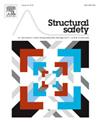Risk-targeted design wind speeds for multi-level aerodynamic performances of long-span bridges: A real data-informed case study
IF 6.3
1区 工程技术
Q1 ENGINEERING, CIVIL
引用次数: 0
Abstract
Most current bridge wind-resistant design standards adopt “uniform hazard” basis, ensuring the resistance exceeds design wind speed at a given return period. However, wind-induced failure probabilities for bridge structures, especially accounting for multi-level performances, are ambiguous, leading to significant differences in risk levels. To achieve the controllability and consistency in aerodynamic performances of long-span bridges, this study introduces the “uniform risk” into bridge wind engineering to determine the risk-targeted design wind speeds. Four performance objectives (occupant comfort, operational, continuous occupancy and instability), associated with the annual failure probability, are summarized. A case study is performed for Xihoumen Bridge by developing fragility curves corresponding to different vibration thresholds. Buffeting-related fragility curves are derived through a data-driven random model based on long-term measurements, while flutter fragility curve is obtained by Monte Carlo simulations incorporating various uncertainties. By combining with the wind hazard curves, failure probabilities for multi-level performances are estimated. Risk-targeted design wind speeds are calculated through the risk integral method, and the annual failure probabilities for code-recommended versus risk-targeted flutter design speeds are compared. Results indicate that Xihoumen Bridge has excessive wind resistance for the continuous occupancy and instability, while the annual failure risk for occupant comfort is relatively high. The code-recommended design wind speed falls short of ensuring multi-level performance objectives, whereas the risk-targeted design wind speeds effectively meet these criteria. This study provides a forward step in bridge wind engineering to develop the “uniform risk” design basis, serving the uptake of performance-based wind engineering design.
大跨度桥梁多层次空气动力学性能的风险目标设计风速:一个真实的数据知情案例研究
现行桥梁抗风设计标准大多采用“均匀危害”原则,保证在给定的回归周期内抗风能力超过设计风速。然而,桥梁结构的风致破坏概率,特别是考虑到多层性能,是模糊的,导致风险水平的显著差异。为实现大跨度桥梁气动性能的可调性和一致性,本研究将“均匀风险”引入桥梁风工程,确定风险目标设计风速。总结了与年度故障概率相关的四个性能目标(乘员舒适性、可操作性、连续使用和不稳定性)。以西堠门大桥为例,建立了不同振动阈值对应的脆性曲线。颤振相关的脆性曲线是通过基于长期测量的数据驱动随机模型推导出来的,而颤振相关的脆性曲线则是通过蒙特卡罗模拟得到的。结合风害曲线,估计了多级性能的失效概率。采用风险积分法计算了风险目标设计风速,比较了规范推荐风速与风险目标设计风速的年失效概率。结果表明,西堠门大桥连续使用和失稳存在过大的抗风能力,而对乘员舒适性的年破坏风险较高。规范推荐的设计风速不能保证多层次的性能目标,而以风险为目标的设计风速则有效地满足了这些标准。本研究为桥梁风工程提供了“均匀风险”设计依据,服务于性能风工程设计的采用。
本文章由计算机程序翻译,如有差异,请以英文原文为准。
求助全文
约1分钟内获得全文
求助全文
来源期刊

Structural Safety
工程技术-工程:土木
CiteScore
11.30
自引率
8.60%
发文量
67
审稿时长
53 days
期刊介绍:
Structural Safety is an international journal devoted to integrated risk assessment for a wide range of constructed facilities such as buildings, bridges, earth structures, offshore facilities, dams, lifelines and nuclear structural systems. Its purpose is to foster communication about risk and reliability among technical disciplines involved in design and construction, and to enhance the use of risk management in the constructed environment
 求助内容:
求助内容: 应助结果提醒方式:
应助结果提醒方式:


